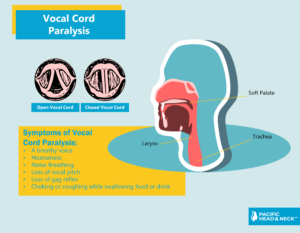Vocal cord paralysis is a common disorder that involves a malfunction in one or both of the vocal cords, the tissues that allow us to speak. When a vocal cord does not open or close properly, the airway is left open, which can allow food or liquids to slip through. This causes difficulty swallowing or breathing, as well as coughing, and often occurs after neck or throat surgery.

Diagnosis
The cause of vocal cord paralysis is often not known, but some patients may develop this condition as a result of:
- Inflammation tumors
- Neck or chest injury
- Viral infection
- Stroke vocal cord injury
Depending on the paralyzed position of the vocal cord, paralysis can cause:
- Hoarseness
- Breathy or weak voice
- Coughing
- Difficulty breathing
- Difficulty speaking loudly
If both vocal cords are affected, symptoms may be severe.
Vocal cord paralysis can be diagnosed through physical examination and a series of diagnostic tests such as an endoscopy, laryngeal electromyography or blood tests. Treatment for vocal cord paralysis depends on the cause, severity and length of the condition, but may include voice therapy or surgery. Voice therapy works to strengthen the vocal cords and keep the airway protected. While surgery may inject bulk to the paralyzed vocal cord, reposition it or insert a breathing tube into the windpipe. Speech therapy may be recommended after surgery to help the patient get used to the changes.
A vestibular balance disorder is diagnosed after reviewing your medical history and examinations.
- Examinations:
- Laryngeal Electromyography (EMG):
- Laryngeal electromyography is a diagnostic exam that evaluates the health of the vocal cord muscles and the nerves that control them by measuring muscle electrical activity. This test is most commonly performed to determine the cause of muscle weakness, as well as to predict recovery from vocal cord paralysis and other related conditions.During the EMG exam, thin needle electrodes are inserted through the skin and into the muscle, where they detect electrical activity while the vocal cord muscle is at rest and contracting. Patients may experience mild pain when the electrodes are inserted, but this is tolerable for most. This test is usually performed in conjunction with a nerve conduction velocity test.
- Laryngeal Electromyography (EMG):








